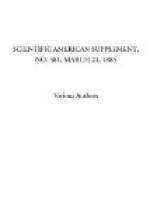In 1840 the school was transferred to the granary building belonging to the city. In 1842, when it contained about fifty pupils, it was made over to the administrative council of the city by the committee of the Society of Arts. From 1824 to 1842 the school had given instruction to about two hundred pupils. From 1843 to 1879 it was frequented by nearly eight hundred pupils, two-thirds of whom were Genevans, and the other third Swiss of other cantons and foreigners.
The school, then, has furnished the watch-making industry with the respectable number of a thousand workmen, among whom large numbers have been, or are yet, distinguished artists.
The rooms of the granary, where the school remained for nearly forty years, became inadequate, despite the successive additions that had been made to them, and it became necessary to completely transform them. The magnificent legacy that the city owes to the munificence of the Duke of Brunswick was partly employed in the reorganization, and the school is now located in a vast building designed to answer the requirements of instruction. This structure, which is located in Necker Street, presents an imposing and severe aspect. The main building embraces most of the workshops, the office, the library, and the classroom for instruction in mechanics, all of which receive a direct light. At right angles with the main building are two wings. The one to the north contains in its three upper stories workshops occupied by classes in escapements, bezil setting, compensating balances, and ruby working. On the ground floor are installed juvenile schools.
The south wing contains halls for lectures on theory, and two workshops looking toward the north. The ground floor is used for the same purpose as that of the north wing.
Finally, in the center of the main building is a wing parallel with its two mates. It is in this that is located the vast staircase that leads to spacious landings at which ends on every story a large corridor common to all the halls and workshops. It is in this part of the building that we find the amphitheater of physics and chemistry and the laboratories. Here also is located the museum in course of formation (gotten up in view of the historical study of watch-making), and the amphitheater designed for certain public lecture courses.
In the way of heating and lighting all parts of the building nothing has been neglected, and special care has been taken to have the ventilation perfect.
At present the instruction comprises a practical and a theoretical course.
Practical Instruction.—This is divided into three sections: (1) an elementary one having in view the construction of the simple watch in its essential parts; (2) a higher section in which the pupils learn to recognize the complicated parts; and (3) a section of mechanics applied to watch-making and to the study of the construction of machines and tools for facilitating and improving the manufacture.




